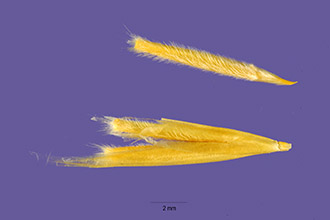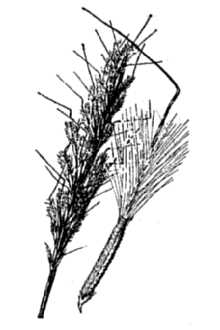Stipa speciosa Trin. & Rupr.
Scientific Name: Stipa speciosa Trin. & Rupr.

| General Information | |
|---|---|
| Usda Symbol | STSP3 |
| Group | Monocot |
| Life Cycle | Perennial |
| Growth Habits | Graminoid |
| Native Locations | STSP3 |
Plant Guide
Use a soil moisture meter to monitor the soil moisture where Stipa speciosa Trin. & Rupr. is planted.
Fact Sheet
Alternate Names
desert stipa, Stipa speciosa
Uses
Grazing/Rangeland: Desert needlegrass is palatable to all classes of livestock when young. After desert needlegrass matures, it is moderately grazed by horses and cattle, but is often avoided by other livestock such as sheep. Soil Stabilization: Desert needlegrass can be used for ground cover in arid areas where there is light disturbance. However, it may not persist in areas with a large population of grazing animals due to excessive trampling and overgrazing. Wildlife: Desert needlegrass is palatable to wildlife such as desert bighorn sheep and feral burros, particularly when young.
Status
Consult the PLANTS Web site and your State Department of Natural Resources for this plant’s current status (e.g., threatened and endangered species, state noxious status, and wetland indicator values). © Dr. D.W. Taylor, Jepson Herbarium
Description
Grass Family (Poaceae). Desert needlegrass is a native, cool-season, perennial bunch grass that grows from 1 to 2 feet tall (30 to 60 cm). The leaf basal sheath is hairy, the leaf blade is generally rolled, and the ligule is short. The inflorescence is compact, 4 to 6 inches long (10 to 15 cm), and is generally partly enclosed by the uppermost leaf sheath. Seeds have an awn approximately 1.5 inches long (38 mm) that is bent once and is hairy below the bend.
Adaptation and Distribution
Distribution
Distribution
Desert needlegrass typically grows on coarse soils with little or no profile development, including alluvial fans, dry rocky hills, talus slopes, and in canyons, Use soil moisture sensors to measure the soil moisture of Stipa speciosa Trin. & Rupr.., Desert needlegrass can tolerate low precipitation environments and usually occurs in areas that receive 6 to 20 inches (15 to 50 cm) of annual precipitation, Desert needlegrass typically grows in Mediterranean climates that have mild winters and warm to hot summers, Desert needlegrass is found throughout many western states, including New Mexico, Colorado, Arizona, Utah, Nevada, California, and Oregon, For current distribution, consult the Plant Profile page for this species on the PLANTS Web site,
Establishment
Desert needlegrass can reproduce vegetatively and by seed. Vegetative reproduction occurs through the annual growth of new tillers. Seed production is highly variable depending on rainfall, and little seed is produced when soil moisture is low and temperatures are high. The long awns of desert needlegrass seed enable self-planting. Cycles of wetting and drying cause the awn to twist and untwist, which drives the seed into the ground. A study on germination rates for desert needlegrass found that germination was greatest for a treatment temperature of 59 degrees Fahrenheit. The study concluded that after 14 days of incubation at 59 degrees Fahrenheit, germination should be more than 90%.
Plant Traits
Growth Requirements
| Temperature, Minimum (°F) | -13 |
|---|---|
| Adapted to Coarse Textured Soils | Yes |
| Adapted to Fine Textured Soils | No |
| Adapted to Medium Textured Soils | Yes |
| Anaerobic Tolerance | None |
| CaCO3 Tolerance | Medium |
| Cold Stratification Required | No |
| Drought Tolerance | High |
| Fertility Requirement | Low |
| Fire Tolerance | High |
| Frost Free Days, Minimum | 120 |
| Hedge Tolerance | None |
| Moisture Use | Low |
| pH, Maximum | 7.7 |
| pH, Minimum | 6.0 |
| Precipitation, Maximum | 14 |
| Precipitation, Minimum | 6 |
| Root Depth, Minimum (inches) | 10 |
| Salinity Tolerance | Low |
| Shade Tolerance | Intolerant |
Morphology/Physiology
| After Harvest Regrowth Rate | Slow |
|---|---|
| Toxicity | None |
| Shape and Orientation | Erect |
| Nitrogen Fixation | None |
| Resprout Ability | No |
| Active Growth Period | Spring and Summer |
| Bloat | None |
| C:N Ratio | Medium |
| Coppice Potential | No |
| Fall Conspicuous | No |
| Fire Resistant | No |
| Flower Color | Yellow |
| Flower Conspicuous | No |
| Foliage Color | Green |
| Foliage Porosity Summer | Moderate |
| Foliage Texture | Medium |
| Low Growing Grass | No |
| Lifespan | Moderate |
| Leaf Retention | No |
| Known Allelopath | No |
| Height, Mature (feet) | 2.0 |
| Growth Rate | Moderate |
| Growth Form | Bunch |
| Fruit/Seed Conspicuous | No |
| Fruit/Seed Color | Brown |
| Foliage Porosity Winter | Porous |
Reproduction
| Small Grain | No |
|---|---|
| Seedling Vigor | Medium |
| Seed Spread Rate | Moderate |
| Seed per Pound | 225000 |
| Fruit/Seed Period End | Summer |
| Propagated by Tubers | No |
| Propagated by Sprigs | No |
| Propagated by Sod | No |
| Propagated by Seed | Yes |
| Propagated by Cuttings | No |
| Propagated by Container | No |
| Propagated by Bulb | No |
| Propagated by Bare Root | No |
| Fruit/Seed Persistence | No |
| Fruit/Seed Period Begin | Summer |
| Fruit/Seed Abundance | Medium |
| Commercial Availability | No Known Source |
| Bloom Period | Late Spring |
| Propagated by Corm | No |
Suitability/Use
| Veneer Product | No |
|---|---|
| Pulpwood Product | No |
| Protein Potential | Low |
| Post Product | No |
| Palatable Human | No |
| Palatable Graze Animal | Medium |
| Palatable Browse Animal | Medium |
| Nursery Stock Product | No |
| Naval Store Product | No |
| Lumber Product | No |
| Fodder Product | Yes |
| Christmas Tree Product | No |
| Berry/Nut/Seed Product | No |

